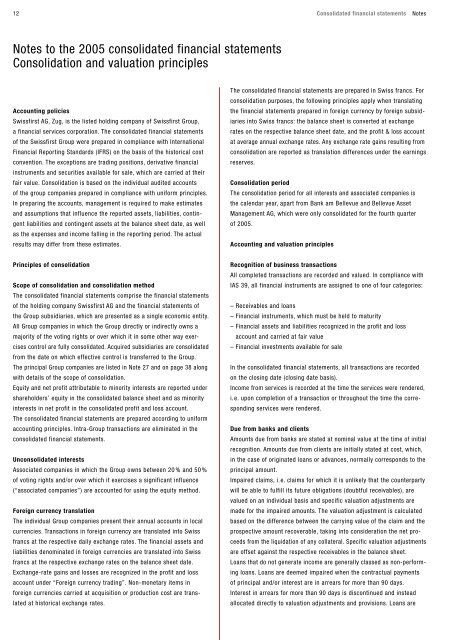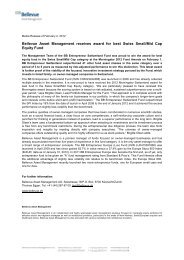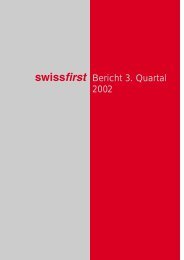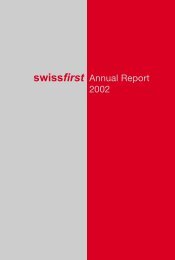Annual Report 2005 - Bank am Bellevue
Annual Report 2005 - Bank am Bellevue
Annual Report 2005 - Bank am Bellevue
Create successful ePaper yourself
Turn your PDF publications into a flip-book with our unique Google optimized e-Paper software.
12<br />
Consolidated financial statements<br />
Notes<br />
Notes to the <strong>2005</strong> consolidated financial statements<br />
Consolidation and valuation principles<br />
Accounting policies<br />
Swissfirst AG, Zug, is the listed holding company of Swissfirst Group,<br />
a financial services corporation. The consolidated financial statements<br />
of the Swissfirst Group were prepared in compliance with International<br />
Financial <strong>Report</strong>ing Standards (IFRS) on the basis of the historical cost<br />
convention. The exceptions are trading positions, derivative financial<br />
instruments and securities available for sale, which are carried at their<br />
fair value. Consolidation is based on the individual audited accounts<br />
of the group companies prepared in compliance with uniform principles.<br />
In preparing the accounts, management is required to make estimates<br />
and assumptions that influence the reported assets, liabilities, contingent<br />
liabilities and contingent assets at the balance sheet date, as well<br />
as the expenses and income falling in the reporting period. The actual<br />
results may differ from these estimates.<br />
The consolidated financial statements are prepared in Swiss francs. For<br />
consolidation purposes, the following principles apply when translating<br />
the financial statements prepared in foreign currency by foreign subsidiaries<br />
into Swiss francs: the balance sheet is converted at exchange<br />
rates on the respective balance sheet date, and the profit & loss account<br />
at average annual exchange rates. Any exchange rate gains resulting from<br />
consolidation are reported as translation differences under the earnings<br />
reserves.<br />
Consolidation period<br />
The consolidation period for all interests and associated companies is<br />
the calendar year, apart from <strong>Bank</strong> <strong>am</strong> <strong>Bellevue</strong> and <strong>Bellevue</strong> Asset<br />
Management AG, which were only consolidated for the fourth quarter<br />
of <strong>2005</strong>.<br />
Accounting and valuation principles<br />
Principles of consolidation<br />
Scope of consolidation and consolidation method<br />
The consolidated financial statements comprise the financial statements<br />
of the holding company Swissfirst AG and the financial statements of<br />
the Group subsidiaries, which are presented as a single economic entity.<br />
All Group companies in which the Group directly or indirectly owns a<br />
majority of the voting rights or over which it in some other way exercises<br />
control are fully consolidated. Acquired subsidiaries are consolidated<br />
from the date on which effective control is transferred to the Group.<br />
The principal Group companies are listed in Note 27 and on page 38 along<br />
with details of the scope of consolidation.<br />
Equity and net profit attributable to minority interests are reported under<br />
shareholders’ equity in the consolidated balance sheet and as minority<br />
interests in net profit in the consolidated profit and loss account.<br />
The consolidated financial statements are prepared according to uniform<br />
accounting principles. Intra-Group transactions are eliminated in the<br />
consolidated financial statements.<br />
Unconsolidated interests<br />
Associated companies in which the Group owns between 20 % and 50 %<br />
of voting rights and/or over which it exercises a significant influence<br />
(“associated companies”) are accounted for using the equity method.<br />
Foreign currency translation<br />
The individual Group companies present their annual accounts in local<br />
currencies. Transactions in foreign currency are translated into Swiss<br />
francs at the respective daily exchange rates. The financial assets and<br />
liabilities denominated in foreign currencies are translated into Swiss<br />
francs at the respective exchange rates on the balance sheet date.<br />
Exchange-rate gains and losses are recognized in the profit and loss<br />
account under “Foreign currency trading”. Non-monetary items in<br />
foreign currencies carried at acquisition or production cost are translated<br />
at historical exchange rates.<br />
Recognition of business transactions<br />
All completed transactions are recorded and valued. In compliance with<br />
IAS 39, all financial instruments are assigned to one of four categories:<br />
– Receivables and loans<br />
– Financial instruments, which must be held to maturity<br />
– Financial assets and liabilities recognized in the profit and loss<br />
account and carried at fair value<br />
– Financial investments available for sale<br />
In the consolidated financial statements, all transactions are recorded<br />
on the closing date (closing date basis).<br />
Income from services is recorded at the time the services were rendered,<br />
i.e. upon completion of a transaction or throughout the time the corresponding<br />
services were rendered.<br />
Due from banks and clients<br />
Amounts due from banks are stated at nominal value at the time of initial<br />
recognition. Amounts due from clients are initially stated at cost, which,<br />
in the case of originated loans or advances, normally corresponds to the<br />
principal <strong>am</strong>ount.<br />
Impaired claims, i.e. claims for which it is unlikely that the counterparty<br />
will be able to fulfill its future obligations (doubtful receivables), are<br />
valued on an individual basis and specific valuation adjustments are<br />
made for the impaired <strong>am</strong>ounts. The valuation adjustment is calculated<br />
based on the difference between the carrying value of the claim and the<br />
prospective <strong>am</strong>ount recoverable, taking into consideration the net proceeds<br />
from the liquidation of any collateral. Specific valuation adjustments<br />
are offset against the respective receivables in the balance sheet.<br />
Loans that do not generate income are generally classed as non-performing<br />
loans. Loans are deemed impaired when the contractual payments<br />
of principal and/or interest are in arrears for more than 90 days.<br />
Interest in arrears for more than 90 days is discontinued and instead<br />
allocated directly to valuation adjustments and provisions. Loans are









